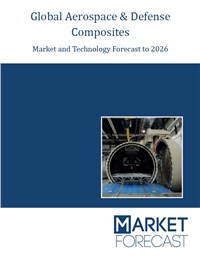The global Aerospace & Defence Composites market is estimated at around USD 15.17 Billion and will grow at a CAGR of around 11.21% to reach USD 39.46 Billion in 2026. The total market opportunity has been estimated at around USD 252 Billion during the forecast period.
Commercial Aviation segment which constitutes the fixed wing commercial aircraft is expected to contribute to more than 50% of the market. The developments in this segment in Jet Engines is expected to contribute to more than 10% of the overall market.
The report has been segmented into Region Wise (Including country wise segmentation), Matrix Wise (Commercial Aviation and Defence & Others), Manufacturing Process and Application Wise (Interior and Exterior).
The report covers in detail the PESTLE analysis, where the Environmental aspects in terms of recycling of the composites are expected to be the major trend changer for this market. It is expected that there will be statutory requirements on increased usage of recycled or reused composite materials.
The report “Global Aerospace & Defence Composite Market Forecast to 2026” provides historical data and the forecast until 2026. The market forecast section provides a segmented forecast across each of the segments as mentioned earlier.Scenarios which could affect the growth of the market and the impacts of these scenarios have been covered in the Scenario Analysis section of the report. The Scenario Analysis covers two scenarios apart from the main expected market movement for the forecasted period.
The in- depth coverage of the report across its sections are:
- Market Overview: This section covers the current state of the market and the past developments which have helped in paving the market. This section deals with Commercial Aviation and Defence separately and has a comparison of various programs which have used composites. This chapter also deals with the key requirements across platforms and the design demands.
- Technology Overview: This chapter deals with the key technologies which would affect the sector, the technical challenges which have been identified are: repair, Design and Structural Stimulation, Crashworthiness, Manufacturing, Recycling and Modelling to name a few.
- Market Segmentation: In this chapter the market segmentation used in this report has been mentioned in detail. The market forecast has been executed based on the segmentation levels in this chapter.
- Market Analysis: The market analysis chapter deals with the key industry trends which includes drivers, restraints and challenges which is expected to shape the growth of this sector.
- Supplier Mapping: Supplier mapping across the key composite suppliers have been mapped, supplier mapping includes 8 Commercial Aviation suppliers and 6 Defence suppliers.
- Market Forecast: This chapter deals with the expected market growth, the segments covered are Region Wise (Including country wise segmentation by End User), Matrix Wise (Commercial Aviation and Defence & Others), Manufacturing Process and Application Wise (Interior and Exterior) with separate forecast for the segments mentioned. It is interesting to note the paradigm shift from Prepreg Preparation method to RTM in the forecast period.
- Scenario Analysis: A detailed scenario analysis has been captured as a part of this chapter, three scenarios have been considered. The assumptions of each scenario and the expected market impacts have been covered in this chapter.
- Opportunity Analysis: This chapter covers the high growth markets and the areas where companies should be focussing on to maximize revenues. The opportunities have been classified as High, Medium and Low Opportunities.
- Company Profiles: Detailed Company profiling is covered for the key players in the market, the company profiles include company information (Including products and Services), Company Financials, Contracts won, alliances and a detailed SWOT of each of companies.
- There has been a constant struggle to optimize the operational cost of airlines, majority of the operational cost was accounted to fuel and to reduce the cost associated with fuel was of significant priority. This increased focus on reducing the weight, which is usually directly proportional to the fuel efficiency has paved the way to advanced composite aircraft which are 50% composite aircraft. The defence market is at a higher maturity in terms of composite usage compared to Commercial Aviation market.
- The environment driven initiatives which are intended to regulate the emissions from airlines are expected to be the major driver, it is expected that such initiatives will be implemented across the other region.
- The program wise supplier mapping across the major commercial and defence programs are covered in Supplier Mapping Section of the report.
- PEST analysis have also been covered as a part of the report, the major companies in the Aerospace & Defence Composite Market have been profiled and a detailed SWOT of each company has been covered as a part of the report.
Reasons to buy:
- Prospective Investors into the Aerospace & Defense Composites market could get a detailed understanding of the market dynamics of the market
- A clear view of the market drivers, restraints and challenges which are expected to affect the market in the next few years.
- Understand the key technology trends in the market including the shifts in manufacturing process.
- Supplier mapping section gives a clear view of the major suppliers across each program and their specific components
- Focus on high growth markets and develop efforts in those markets
- Understand the competitor dynamics with respect to the recent alliances, and financial information



